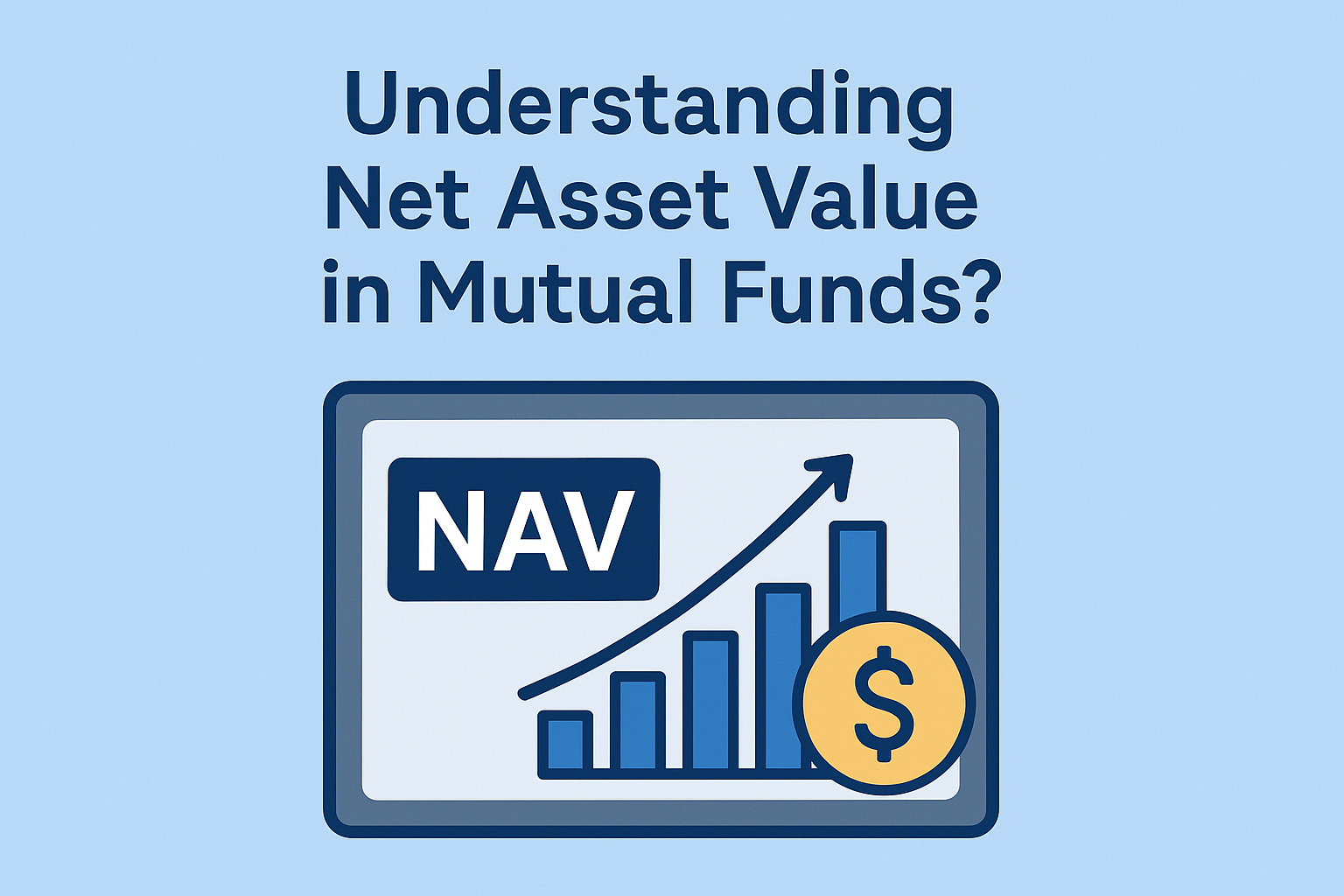Understanding Net Asset Value in Mutual Funds?

Introduction:
If you’ve ever invested in mutual funds, you must have come across the term NAV. Several investors, especially beginners, often wonder what NAV actually means and how it can affect their investment journey.
While, to a beginner, it may sound technical, NAV is simply the per-unit price of a mutual fund scheme. In simple words, NAV helps you understand how much one unit of a mutual fund is worth on a given day.
Therefore, there is no denying that it is important to understand NAV meaning in SIP, mutual funds, and other investment options, to make better and informed financial decisions. In this article, we will discuss NAV in detail, how it is calculated, why it matters, and how investors can use this understanding for better financial decisions.
What is the Net Value of Assets for Mutual Funds?
The Net Value of Assets refers to the total worth of all investments held by a mutual fund. This includes:
- Equity shares (if it’s an equity fund)
- Debt instruments (bonds, debentures, etc.)
- Cash reserves
- Accrued income like dividends or interest
From this total, the fund’s liabilities (management expenses, fees, and other costs) are subtracted. The result is the fund’s net assets. Dividing this by the number of outstanding units gives us the NAV.
For example: If the NAV of a fund is INR 100, its one unit is priced at INR 100 on that day.
NAV Formula with Example
The nav formula is pretty straightforward:
NAV = (Total Assets – Total Liabilities) ÷ Number of Outstanding Units
Example: Suppose a mutual fund has:
- Total Assets: ₹500 crore
- Total Liabilities: ₹20 crore
- Outstanding Units: 4 crore
Then,
NAV = (₹500 crore – ₹20 crore) ÷ 4 crore
NAV = ₹480 crore ÷ 4 crore = ₹120 per unit
This means each unit of the mutual fund is worth ₹120.
How is the Net Value of an Asset Calculated?
The calculation of NAV involves valuing each security held in the fund’s portfolio. The remaining amount is then divided by the outstanding units to give the NAV.
- Equity valuation: Shares are valued at the day’s closing market price.
- Debt instruments: Valued at market price or yield-based methods as per SEBI guidelines.
- Cash and receivables: Added directly to the asset pool.
- Expenses and liabilities: Deducted from the total asset value.
How is NAV Relevant to Investors?
Many investors mistakenly assume that a lower NAV means the fund is cheaper or better. However, this is not true. NAV is not like a stock price; it simply reflects the per-unit value of the fund.
- A fund with an NAV of ₹15 is not necessarily better or worse than one with ₹150.
- What truly matters is the performance of the fund’s portfolio, not the NAV itself.
However, NAV is relevant in these ways:
- It determines the number of units you get for your investment.
- It helps track your investment value over time.
- It ensures transparency, as NAV is updated daily.
For SIP investors, understanding nav meaning in SIP is crucial because NAV determines how many units are allotted for each SIP installment.
Role of NAV in the Performance of a Fund
NAV plays a supportive role in tracking performance but is not a measure of performance itself. Fund managers, however, focus on overall portfolio returns rather than just NAV numbers. Investors should compare returns, risk profile, fund objectives, and consistency rather than picking funds solely based on NAV.
- If a fund’s NAV increases from ₹100 to ₹110 in a year, it indicates a 10% growth.
- The percentage change in NAV reflects how much your investment has appreciated.
NAV Allotment for Different Investment Types
When you invest in mutual funds, the way NAV is applied can differ based on the type of investment you choose. Whether you invest through a lumpsum, SIP, SWP, or switch between funds, the allotment of units depends on the prevailing NAV on the transaction day.
Understanding this helps investors know how their money is converted into units and how returns are calculated.
Lumpsum Investment: When you invest a lumpsum, the NAV of that day (if invested before cut-off) is used to allot units.
Systematic Investment Plan (SIP): For SIP, every installment buys units at the prevailing NAV of the chosen date. Over time, this helps average out the cost, known as Rupee Cost Averaging. Understanding the nav meaning in SIP helps investors see how units accumulate regularly.
Systematic Withdrawal Plan (SWP): In an SWP, units are redeemed at the prevailing NAV to generate regular payouts.
Switching Funds: When switching between schemes of the same fund house, units are redeemed and re-allotted based on the respective NAVs.
Common Misconceptions About NAV
Many investors assume that a higher or lower NAV directly reflects a fund’s performance, but this isn’t true. And, there are many more. Here are some of the misconceptions that when cleared can help you make better investment decisions.
- Low NAV = Better Investment?: Not true. NAV only reflects per-unit price, not performance.
- High NAV = Expensive Fund?: Again, incorrect. NAV has no bearing on affordability, as the entry cost is the same (you can invest small amounts in any scheme).
- NAV Predicts Future Returns?: NAV shows past performance but does not guarantee future returns.
Why NAV Matters in SIP Investments?
When investing through a Systematic Investment Plan (SIP), the Net Asset Value (NAV) plays a crucial role in determining how many units you receive for your investment. While SIPs average out market volatility over time, understanding NAV helps you see how your money is allocated and tracked.
Here are the key points that you must understand:
- Unit Allocation
- Rupee Cost Averaging
- Performance Tracking
- Transparency
Practical Example of NAV in SIP
To understand how NAV works in a Systematic Investment Plan (SIP), let’s take a simple example. Suppose you decide to invest INR 5,000 per month in a mutual fund through SIP for 6 months. The NAV of the fund changes every month based on the market value of its portfolio.
| Month | SIP Amount (INR) | NAV (INR) | Units Purchased (₹5,000 ÷ NAV) | Total Units Accumulated |
| 1 | 5,000 | 50 | 100.00 | 100.00 |
| 2 | 5,000 | 40 | 125.00 | 225.00 |
| 3 | 5,000 | 45 | 111.11 | 336.11 |
| 4 | 5,000 | 55 | 90.91 | 427.02 |
| 5 | 5,000 | 60 | 83.33 | 510.35 |
| 6 | 5,000 | 48 | 104.16 | 614.51 |
At the end of 6 months:
- Total invested = INR 30,000
- Total units accumulated = 614.51
- If the current NAV is INR 52, the portfolio value = 614.51 × 52 = INR 31,954.52
This shows how SIP investments benefit from rupee cost averaging:
- When NAV is low, you buy more units.
- When NAV is high, you buy fewer units.
Key Takeaways for Investors
Understanding NAV helps investors make smarter decisions while investing in mutual funds. It is not the only factor for evaluating a fund, but it plays a crucial role in tracking investments and returns.
Here are key takeaways:
- NAV shows the per-unit value of a mutual fund scheme.
- A higher or lower NAV does not mean better or worse performance.
- In SIPs, NAV determines how many units you buy each installment.
- NAV fluctuates daily with changes in the fund’s portfolio value.
- Consistent fund performance matters more than just NAV.
Conclusion
Understanding NAV is fundamental for mutual fund investors. While NAV tells you the per-unit value of your investment, it should not be mistaken as a measure of fund performance. The nav formula helps in calculating NAV, but investors should look beyond numbers and evaluate fund objectives, consistency, and long-term returns.
At Mentor Wealth, we help you understand complex financial terms like NAV in simple language and guide you toward smarter investment choices. Whether it’s SIP, lumpsum, or goal-based investing, we ensure that your wealth-building journey is transparent, informed, and aligned with your goals.

Let’s grow your wealth, together
We’ve Spent 10+ Years Helping Clients
Like You Find Financial Confidence
Insights that empower your investments
Explore expert-written blogs on mutual funds, market trends,
and smart investment strategies
Let's build a wealthy Tomorrow
25+ years of experience helping investors find financial confidence



